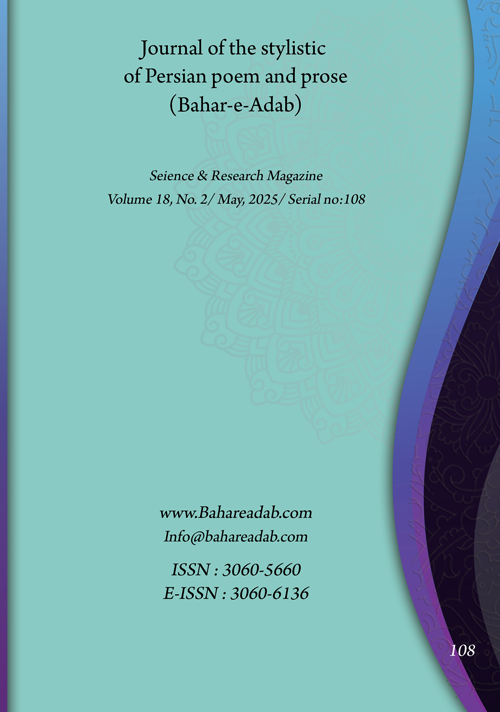- Count View : 200
- آدرس کوتاه شده مقاله: https://bahareadab.com/article_id/1815
- کد doi مقاله: Doi: 10.22034/bahareadab.2025 .18 .7754
Journal of the stylistic of Persian poem and prose
volume Number 18،
number In Volume 2،
،
issue Number 108
Death and Resurrection in the Garshasbnameh, Bahmannameh, and Borzunameh
Safora Mirbaha , Ataullah Koopal (Author in Charge), Nastaran Safari
Abstract
BACKGROUND AND OBJECTIVES: Fear and anxiety about the passage of time and the end of worldly life have always been the main concerns of mankind, and liberation from death and finding the water of life and the plant of youth to become immortal have become the motifs of the creation of world myths. In fact, epic death is the meeting point of pleasure with the deepest sorrow in a collective narrative; it is the meeting point of two conflicting ideas: mortality and immortality. In the epic narrative, death finds a deep connection with survival, and the individual, in his identification with the hero of the epic, finds survival in death. In this regard, the present article examines the two key concepts of "death and resurrection" in the poetic systems of the Garshasbnameh, Bahmannameh, and Borzunamah. The main emphasis in this research is on revealing the ethical issues and the religious and doctrinal themes in these works about death.
METHODOLOGY: The article uses a descriptive-analytical method to comparatively examine the similarities and differences in the attitudes of the three aforementioned epics towards the issue of death and resurrection. In this study, the researchers seek to explain how Garshasbnameh, Bahmannameh and Borzonameh view the issue of death and resurrection.
FINDINGS: The aforementioned epic poets, in their dealings with death, often come up with concepts such as the emptiness of the world, its disloyalty, the predestination and inevitability of death, the mystery of the world and the impermanence of its work. In the epic world, due to the warlike atmosphere and the confrontation with death, all heroes have always faced the issue of death. These heroes choose death while they could easily avoid it or fight it. Therefore, their death gives another meaning to life.
CONCLUSION: In general, it can be said that the purpose of these poets in addressing death is to strengthen the courage of the heroes and not to fear the enemy, to die for the glory of Iran, and to defend the homeland with a self-willed death. In fact, their insistence on showing the impermanence of this world in comparison with the eternity of the hereafter is to show the insignificant and unimportant pleasures and worldly attachments in line with choosing death and not to fear it; this is because the Iranian heroes considered heaven to belong to those who die in the defense of their homeland and its ideals.
Keyword
Borzuname
, Bahmaname
, Garshasbname
, Death
, Resurrection
, Epic
- The Holy Quran
- Al-Hindi Al-Burhan Furi, Alaeddin Ali Al-Muttaqi. (1982). Kanz al-Ummal, Beirut: Dar al-Ahyaa Turath al-Arabi.
- Anjavi Shirazi, Seyyed ab al-Qasem. (1976). People and Ferdowsi, Tehran: Soroush.
- Asadi Tusi, Ali ibn Ahmad. (1975). Garshasbnameh, edited by Habib Yaghmaei, Tehran: Tahori Library.
- Ata ibn Yaqoub, Amid. (Ata’ei Razi). (2003). BorzuNameh, edited by Mohammad Dabirsiyaghi, Tehran: Association of Cultural Works and Honors.
- Avesta. (2007). Edited by Jalil Dostkhah, Tehran: Morvarid.
- Aydenlou, Sajjad. (2009). Poetic Texts of Pahlavani, Tehran: Samt.
- Baghdadi, Abdul Qadir ibn Omar. (2003). Shahnameh Dictionary, edited by Karl. K. Zalman, translated by Towfiq. E. Sobhani and Ali Ravaghi, Tehran: Publications of the Association of Cultural Works and Honors.
- Bahar, Mehrdad. (1996). A Study in Iranian Mythology, Tehran: Agah.
- Dehkhoda, Ali Akbar. (1998). Dictionary, fourth edition, Tehran: Tehran University Press.
- Ferdowsi, Abolghasem. (2019). Shahnameh, based on the Moscow edition, edited by Saeed Hamidian, Tehran: Ghatre.
- Haft Lashkar (Collection of Writers). (1998). Introduction and correction by Mehran Afshari and Mehdi Madaeni, Tehran: Institute of Humanities and Cultural Studies.
- Iranshah ibn Abi al-Kheyr. (1991). Bahmannameh, edited by Rahim Afifi, Tehran: Scientific and Cultural.
- Mehraki, Iraj. (2001). "The Evolution of the Character of Garshasb in Myth and Epic", Journal of the Faculty of Literature and Humanities, Issue 32, pp. 197-214.
- Omidsalar, Mahmoud. (2005). "Dragon", Encyclopedia of Persian Language and Literature, Volume 1, edited by Esmaeil Sa’adat, Tehran: Persian Language and Literature Academy, pp. 357-358.
- Rahmani, Roshan. (2007). "The Tale of Borzo" in the Speech of Joreh Kamal (Scholarly Text). Dushanbe: National State University of Tajikistan.
- Rastegar Fasa’i, Mansour. (1999). Dragon in Mythology, Tehran: Toos.
- Sa'alebi Neyshaburi, Abdolmalek ibn Mohammad. (1989). Tarikh Sa'alebi, translated by Mohammad Fazaili, Tehran: Noghreh.
- Saeedi, Seyyed Mostafa and Hashemi, Ahmad. (2002). The Shahnameh Scroll of Ferdowsi, Tehran: Noushnegar.
- Salmi, Abbas. (1994). "A Study on the Borzunameh and Its Different Contexts," Journal of the Faculty of Literature and Humanities, Ferdowsi University of Mashhad, (1) 27, pp. 15-34.
- Sarami, Ghadamali. (1999). From the Color of Flowers to the Pain of Thorns, Tehran: Scientific and Cultural.
- Shamisa, Sirous. (1994). Literary Varieties, Second Edition, Tehran: Ferdowsi.
- Zanjani, Mahmud. (2001). Comprehensive Dictionary of the Shahnameh, second edition, Tehran: Ata'i Printing House.

